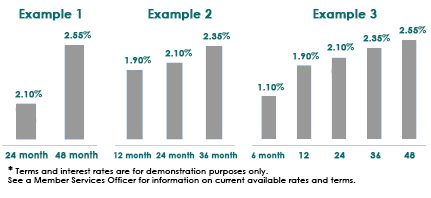How a CD Laddering Strategy Can Benefit You
How a CD Laddering Strategy Can Benefit You
In an unpredictable rate environment, share certificates are one of the safest investments you can make. When you commit to a share certificate you know exactly how long your money will be tied up and exactly how much you will get in return.
While share certificates usually offer higher returns than savings accounts, money-market accounts, and interest-bearing checking accounts, they do require you to park your money for a specific amount of time to realize gains, otherwise you will most likely have a penalty for withdrawing money early. Generally, the longer the certificate’s term, the higher the interest rate will be.
For many people, it is difficult to lock away money knowing that you won’t have access to it. With a share certificate laddering strategy, you can take advantage of higher rates, while still having regular access to your funds. Laddering is a technique that involves dividing your savings across two, three, or more share certificates. By doing this, the maturity dates will be staggered and it will allow you to access part of your savings on a regular basis. At maturity date of each share certificate, you can decide whether you would like to withdraw the money or reinvest it in another share certificate.
The way you want to create your share certificate ladder is to choose several different term lengths, that way the maturity dates will all vary. Some people like to always replace the longest maturity because you typically get the highest rate available at the time. Here are some examples:
At Sandia Area the shortest share certificate term is 6-months and the longest term is 48-months. We have several term options in between as well that would make a solid laddering strategy similar to the third example. The minimum balance required for all share certificates is only $500 and you are guaranteed return on your investment upon maturity date. Stop and see a Member Services Officer for more information on our current rates and terms.
« Return to "Sandia Area Blog" Go to main navigation

